Rail transport in Switzerland
| Switzerland | |||||||
|---|---|---|---|---|---|---|---|
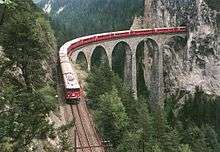 | |||||||
| Operation | |||||||
| National railway | Swiss Federal Railways | ||||||
| Major operators |
Swiss Federal Railways (SBB CFF FFS) BLS AG (BLS) Rhaetian Railway (RhB) Matterhorn-Gotthard-Bahn (MGB) | ||||||
| System length | |||||||
| Total | 5,323 km (3,308 mi)[1] | ||||||
| Electrified | 99% | ||||||
| High-speed | 137[note 1] km (85.1 mi) | ||||||
| Track gauge | |||||||
| Main | 1,435 mm/4 ft 8 1⁄2 in standard gauge | ||||||
| High-speed | standard gauge | ||||||
| 1,000 mm metre gauge | 865.7[note 1] km (537.9 mi)[2][3][4][5][6][7] | ||||||
| 800 mm | 55.2 km (34.3 mi) | ||||||
| 750 mm | 13 km (8.1 mi) | ||||||
| 1,200 mm | 1.964 km (1.2 mi)[6] | ||||||
| Electrification | |||||||
| Main | 15 kV 16.7 Hz | ||||||
| standard gauge | 3,773.4[note 1] km (2,344.7 mi)[8][9][10][11][5][6] | ||||||
| metre gauge | 865.7[note 1] km (537.9 mi)[2][3][4][7][5][6] | ||||||
| Features | |||||||
| No. tunnels | 612[note 1][8][9][2][3][4][5][6][7][12] | ||||||
| Tunnel length | 439.4[note 1] km (273.03 mi)[8][9][10][2][3][4][6][7][12] | ||||||
| Longest tunnel | Gotthard Base Tunnel 57.09 km (35.47 mi) | ||||||
| No. bridges | 7558[note 1][8][9][10][2][3][4][5][6][7][12] | ||||||
| No. stations | 1838[1] | ||||||
| Highest elevation | Jungfraujoch railway station | ||||||
| at | 3,454 metres (11,332 ft) | ||||||
| Lowest elevation | Piano di Magadino | ||||||
| at | 200 metres (660 ft) | ||||||
| |||||||
The Swiss rail network is noteworthy for its density,[13][14] its coordination between services, its integration with other modes of transport, timeliness[15][16] and a thriving domestic and trans-alp freight system. This is made necessary by strong regulations on truck transport,[17] and is enabled by properly coordinated intermodal logistics.[18]
In 2015, with 5,323 kilometres (3,308 mi) network length, Switzerland has not only the world's most dense railway network (128.9 km/103km2, except for very small countries and city-states) despite the Alps covering about 60% of its surface, but it is also a world leader in kilometres traveled: 2,459 km (1,528 mi) per inhabitant and year (2015). Virtually 100% of its network is electrified, except for the few tracks on which steam locomotives operate for tourism purposes only. There are 74 railway companies in Switzerland. The share of commuters who travel to work using public transport (as main mode of transport) is 30%. The share of rail in goods transport performance by road and rail (modal split) is 39%.[1]
Switzerland is a member of the International Union of Railways (UIC). The UIC Country Code for Switzerland is 85.[19]
Standard-gauge lines
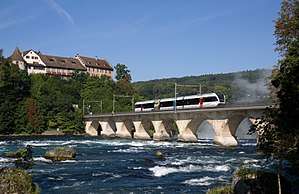
Three quarters of the Swiss rail network is at standard gauge, comprising 3,773 km (2,344.4 mi), administered mostly by three companies. Important railway stations are the Zürich HB (466,800 passengers per day on a working day), Bern (210,000 ppd), Basel SBB (114,200 ppd), Lausanne (108,900 ppd), Winterthur (108,000 ppd), Luzern (96,200 ppd), Zürich Oerlikon (85,700 ppd), Zürich Stadelhofen (83,300 ppd), Olten (81,300 ppd), and Geneva (73,700 ppd).[20]
Swiss Federal Railways
Swiss Federal Railways (SBB CFF FFS) is the largest railway company in Switzerland and handles the majority of national and international traffic. It operates the main east-west track in the Swiss Plateau area calling all larger Swiss cities and many smaller ones, and the north-south routes through the Alps via the Gotthard Line (Milano-Chiasso-Lugano-Luzern/Zurich-Basel line) and the Simplon Tunnel (Domodossola to Brig-Lausanne-Geneva line).[8]
- Total route length: 3,173 km (1,971.6 mi).[21]
BLS
BLS (Bern-Lötschberg-Simplon) is the other main company, with 10% of the standard-gauge network. It manages the other major Alpine route Bern-Brig via both Lötschberg Tunnels and connection at Brig with SBB's Simplon Tunnel to Italy.[22]
- Total route length: 436 km (270.9 mi).[9]
SOB
The Schweizerische Südostbahn AG (SOB) operates on 147 km (91.3 mi) (of which 123 km (76.4 mi) are their own) between Romanshorn on Lake Constance to St. Gallen. And further via Herisau to the Toggenburg valley in northeast Switzerland. Via Wattwil and Rapperswil SOB travels the track over the Seedamm on Lake Zurich and finally over the high moorland of Rothenthurm down to Arth-Goldau in Central Switzerland.
The named train Voralpen Express (VAE, Pre-Alpine Express) is operated by the Südostbahn. It runs every hour between Lucerne and St. Gallen.[10]
Rail links to other countries
- Standard gauge 1,435 mm (4 ft 8 1⁄2 in)
- Austria – same voltage 15 kV, 16.7 Hz AC
- France – voltage change 15 kV, 16.7 Hz AC / 25 kV, 50 Hz AC or 1,500 V DC
- Germany – same voltage 15 kV, 16.7 Hz AC
- Italy – voltage change 15 kV, 16.7 Hz AC / 3 kV DC
- Liechtenstein – same voltage 15 kV, 16.7 Hz AC
Although both Austria and Germany use the same voltage as Switzerland, dedicated types of locomotives are necessary due to Switzerland using narrower pantographs.
The German national railway company Deutsche Bahn (DB) owns cross-border lines from the German border to Basel Badischer Bahnhof station, which is also operated by DB. It also owns and operates an east-west line across the Canton of Schaffhausen that forms a link in the largely German Upper Rhine Railway, and jointly owns Schaffhausen railway station with the Swiss Federal Railways.
The German DB operates longer-distance trains from Germany to Swiss cities, including ICE services to Basel, Zurich, Berne, Chur and Interlaken. On the other hand, Swiss operators run several trains into Germany, e.g. regular EC service to Stuttgart.
The French-Swiss joint-venture TGV Lyria operates high-speed trains between Paris and South-France with services to Geneva, Lausanne, Berne, Interlaken, Basel and Zurich.
The Austrian Railjet by ÖBB operates the service between Zurich and several destinations in Austria. The service runs via Buchs SG and calls Innsbruck, Salzburg and Vienna besides others.
SBB and Trenitalia jointly operate EuroCity services between Switzerland and Italy. These services are running between Geneva and Milan or even Venice via the Simplon Tunnel. Between Basel and Milan via Berne and the Lötschberg Base and Simplon Tunnels, and between Zurich and Milan via the Gotthard route.
Narrow-gauge lines
RhB and MGB
The Rhätische Bahn (RhB) is the longest metre-gauge railway in Switzerland, linking Arosa, Disentis, Davos, St. Moritz in the high Alps, and Tirano in Italy with Chur, a rail junction with the SBB. It passes through the upper Rhine Valley and several side valleys, as well as the Engadine, the upper valley of the river Inn. The Bernina Pass is the highest point on this line, at 2253 m. Total length: 366 kilometres.[2]
The former Furka Oberalp Bahn (FO) was a metre-gauge railway in the high southern alps. Its name referred to two passes, the Furka Pass and the Oberalp Pass. The Furka Pass lies at the upper end of the Rhône valley. The Oberalp Pass is the highest point on this line at 2033 metres, and lies at the upper end of the Rhine valley. The total length of the railway was 100 kilometres, and the line runs from Disentis to Brig. Brig is a rail junction with the SBB and BLS and sits at the north end of the Simplon tunnel on the Milan to Lausanne CFF line and Milan to Bern BLS line.
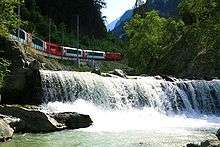
The former BVZ Zermatt-Bahn (BVZ; BVZ means Brig Visp Zermatt) was a short line between Brig and Zermatt. It passes through the Visp and Matt Valleys, tributaries of the Rhône. Total length: 43 kilometres.
In 2003, the FO and BVZ merged to form the Matterhorn Gotthard Bahn (MGB).[3]
The Glacier Express (GEX) runs on the combined three line route St. Moritz/Davos-Filisur-Chur-Disentis-Andermatt-Brig-Visp-Zermatt. A one-day trip in panoramic-view cars takes tourists from St. Moritz/Davos to Zermatt, or vice versa, through some of the most spectacular scenery of the Alps.
Further narrow-gauge lines
The Appenzeller Bahnen (AB) with its total of 77 km of mainly metre-gauge tracks just recently combined (2006) the earlier separate Trogenerbahn from St. Gallen to Trogen, the standard-gauge railway from Rorschach, Switzerland to Heiden, Switzerland, the short track of the funiculair from Rheineck to Walzenhausen, as well as the previous Appenzeller Bahnen. The AB connects main spots within both Appenzells with St. Gallen and Altstätten in the Alpine Rhine Valley.[6]
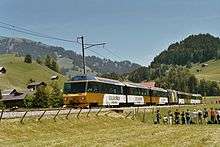
The Chemin de Fer Montreux Oberland Bernois (MOB) line runs 75 kilometres from Montreux on Lake Geneva to Zweisimmen, with a connecting line to Lenk in the Simmental. The section from Montreux to Zweisimmen, approximately 63 kilometres long, is part of the "Golden Pass Panorama" trip from Montreux to Lucerne, a trip which combines rides on the MOB, the BLS and the Zentralbahn (zb).[7][12]
From Interlaken, the narrow-gauge Brünigbahn section of the Zentralbahn (zb) runs 74 kilometres further to Lucerne. It skirts Lake Brienz and passes through the range of mountains to the north of the lake via Brünig Pass, and then drops into the Sarner Aa valley to Lucerne. The zb also runs the line between Lucerne and Engelberg.[4]
The Chemins de fer du Jura (CJ), the railways of the Jura canton in northern Switzerland, is an 85-kilometre rail network of which 74 km is metre gauge, the remaining 11 km being standard gauge. It connects La Chaux-de-Fonds to Glovelier and Tramelan, both via Le Noirmont.[5]
The Wynental- und Suhrentalbahn operates in the canton of Aargau in the two mentioned valleys connecting them in Aarau, over a total length of 32.3 km.

The Berner Oberland Bahn (BOB) is a 24-kilometre line from Interlaken to Lauterbrunnen and Grindelwald. It begins at Interlaken Ost station and divides at Zweilütschinen, about 10 kilometres south of Interlaken. The western branch leads to Lauterbrunnen, while the eastern branch leads to Grindelwald. It is possible to make a loop by taking the Lauterbrunnen branch and returning via the Grindelwald branch. The two branches are connected by the Wengernalp Bahn.
The Wengernalpbahn (WAB) is a 19-kilometre line from Lauterbrunnen to Grindelwald, leading over the Eiger ridge at the junction station of Kleine Scheidegg. In the winter, this junction is a ski resort served by many lifts and trails, as well as the rail line. Skiers can ride the train from the valleys below to return to the top of the runs.
The Jungfraubahn (JB), which is also rack-and-pinion throughout, starts at Kleine Scheidegg and runs 9 kilometres through tunnels in the Eiger and Mönch, leading to the "Jungfraujoch," a saddle between the Mönch and the Jungfrau summits. At the saddle are a visitor centre and an observatory. The Aletsch Glacier, largest in Europe, runs to the south toward the Rhône valley.
The Bergbahn Lauterbrunnen-Mürren (BLM) is 6 km long, divided into two independent parts, the first part being a cable car (which runs above the old funicular railway, which was replaced in 2006), the second an adhesion railway.
The Chemin de fer Martigny–Châtelard (MC) is 19 km long, with one rack railway section, in the canton of Valais. It connects with the Saint-Gervais–Vallorcine railway in France, the joint services being marketed as Mont-Blanc Express.
In the canton of Vaud, metre-gauge railways include the Chemin de fer Nyon-St-Cergue-Morez, the Chemin de fer Bière-Apples-Morges, the Chemin de fer Yverdon–Ste-Croix, the Chemin de fer Bex–Villars–Bretaye and the Chemin de fer Lausanne–Echallens–Bercher, as well as part of the longer MOB.
The Ferrovia Lugano–Ponte Tresa (FLP), in Canton Ticino, runs 12.3 kilometres from Lugano to Ponte Tresa.
The Gornergrat Bahn climbs for 9 kilometres from an elevation of 1600 metres near the Zermatt station of the Zermatt RR to a 3000-metre high-end station on the shoulder of the Monte Rosa Mountain. The entire route is a rack-and-pinion railway.
At Brienz the Brienz Rothorn Bahn (BRB), a steam-hauled rack railway, ascends to near the summit of the Brienzer Rothorn.
Narrow-gauge links to adjacent countries
1,000 mm/3 ft 3 3⁄8 in metre gauge
- Italy:
- Bernina Railway, break-of-gauge and voltage change at Tirano
- FART (ferrovie autolinee regionali ticinesi) railway line between Locarno and Domodossola through the Swiss Centovalli and Italian Valle Vigezzo.
Urban rail
Trams
There are trams operating on nine systems in seven Swiss cities. Street-running tramways are nearly all 1,000 mm (3 ft 3 3⁄8 in). The Chemin de fer Bex–Villars–Bretaye (BVB) in Bex is more of a mixed interuban light rail line connected to a rack railway but it does have some street running portions, particularly in Bex where the BVB operates along the right of way of a tramway system originally built in the 1890s.
| City | System | Start of electric operations |
Gauge | notes |
|---|---|---|---|---|
| Basel | Basler Verkehrs-Betriebe (BVB)[23] | 6 May 1892[23] | 1,000 mm (3 ft 3 3⁄8 in) metre gauge | 8 lines |
| Baselland Transport (BLT)[23] | 6 October 1902 | 1,000 mm (3 ft 3 3⁄8 in) metre gauge | 4 lines, 65.2 km (40.5 mi), 100 trams, serves suburbs | |
| Bern[23] | Städtische Verkehrsbetriebe Bern | 1 July 1902 | 1,000 mm (3 ft 3 3⁄8 in) metre gauge | |
| Bex | Bex–Villars–Bretaye railway (BVB) | 1898 | 1,000 mm (3 ft 3 3⁄8 in) metre gauge | connects to rack railway in Villars-sur-Ollon |
| Geneva[23] | Transports Publics Genevois | 22 September 1894 | 1,000 mm (3 ft 3 3⁄8 in) metre gauge | |
| Lausanne | Tramway du sud-ouest lausannois | 2 June 1991 | 1,435 mm (4 ft 8 1⁄2 in) standard gauge | |
| Neuchâtel[23] | Trams in Neuchâtel | 16 May 1897 | 1,000 mm (3 ft 3 3⁄8 in) metre gauge | |
| Zürich[23] | Verkehrsbetriebe Zürich (VBZ) | 8 March 1894 | 1,000 mm (3 ft 3 3⁄8 in) metre gauge | |
| Stadtbahn Glattal | 10 December 2006 |
S-Bahn
In German-speaking parts of Switzerland suburban commuter rail service is known as the S-Bahn and radiates from major urban centers like Zürich S-Bahn and the Basel Regional S-Bahn. Commuter rail service in the French-speaking parts of Switzerland surrounding Geneva is limited to two shortlines known as the Rhône Express Régional.
The oldest S-Bahn network in Switzerland is the Bern S-Bahn, established in stages from 1974. The Zürich S-Bahn went into service in 1990. The Basel Regional S-Bahn, opened in 1997, services the Basel metropolitan area, thus providing cross-border transportation into both France and Germany. The Léman RER is an ongoing project by the Canton of Geneva to connect and expand the two Rhone Express Regional lines into a network serving the entire Geneva metropolitan area including adjoining communities in France.
S-Bahn services were set up in the course of the Bahn 2000 initiative in Central Switzerland (a collaborative network of S-Bahn Luzern and Stadtbahn Zug), St. Gallen (S-Bahn St. Gallen) and Ticino (Rete celere del Canton Ticino).
History
The construction and operation of Swiss railways during the 19th century was carried out by private railways. The first internal line was a 16 km line opened from Zürich to Baden in 1847. By 1860 railways connected western and northeastern Switzerland. The first Alpine railway to be opened under the Gotthard Pass in 1882. A second alpine line was opened under the Simplon Pass in 1906.
In 1901 the major railways were nationalised to form Swiss Federal Railways. During the first half of the twentieth century they were electrified and slowly upgraded. After the Second World War rail rapidly lost its share of the rail market to road transport as car ownership rose and more roads were built. From 1970 the Federal Government has become more involved in upgrading the railways, especially in urban areas and on trunk routes under the Rail 2000 project. In addition, two major trans-alpine routes—the Gotthard Railway and the Lötschberg approach to the Simplon Tunnel—are being rebuilt under the NRLA project.
Integration of services
Between rail services
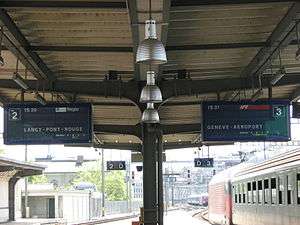
Services on the Swiss railway are integrated with each other and with other forms of public transport. Unlike its European neighbours, Switzerland has not developed a comprehensive high-speed rail network,[24] with the running speed on its one stretch, called the Rothrist-Mattstetten line, of relatively high-speed line being 200 km/h.[25] Instead the priority is not so much the speeding up of trains between cities, but the reduction of connection times through the nodal system.[26] Journey times on main lines between hubs are multiples of 15 minutes so that on the hour or half-hour all trains stand in the main stations at the same time, thus minimising connection times. Indeed, the above-mentioned Rothrist-Mattstetten line reduces journey times from Bern to Zurich from 72 minutes to 57 minutes,[27]:29 in keeping with the clock face scheduling.
Between modes of transport
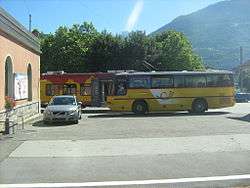
Rail timetables are integrated[27]:36 with the extensive[27]:18 network of postal buses (branded as PostBus, French: CarPostal, German: PostAuto, Italian: AutoPostale) which serve both plain and high mountain villages. For example, on postal bus line 12.381[28] the 10:35 from the mountain village of Les Haudères is planned to arrive in the regional city of Sion at 11:20 where a train departs the station (located next to the bus station) at 11:24 for Visp. Indeed, it is a familiar sight to for the postal cars to be already lined up outside the station for the arriving train. From this perspective, the Swiss rail network functions as the core of a wider public transport network.
Costs and subsidies
Passenger transport
In 2012, the total costs for passenger transport on Swiss railway network was CHF 8.88 billion, of which CHF 4.46 billion (50%) were due to infrastructure costs, CHF 3.98 billion (45%) were costs of transportation means, CHF 427 million due to environmental and health costs, and CHF 25 million due to accidents.[29]
CHF 4.28 billion, or 48.2%, were paid by passengers, and CHF 4.15 billion (or 47%) came from rail subsidies provided by federal, cantonal, and municipal contributions. CHF 426 million (or 4.8%) were contributed by the common weal (accident and health insurances, environmental funds etc.).[29]
Freight transport
In 2012, the total costs for freight transport on Swiss railway network was CHF 2.063 billion, of which CHF 779 million (37.8%) were due to infrastructure costs, CHF 900 million (43.6%) were costs of transportation means, CHF 59 million due to environmental and health costs, and CHF 325 million (15.8%) due to accidents.[29]
CHF 1.058 billion, or 51.3%, were paid by customers, and CHF 122 million (5.9%) by transporting companies, while CHF 555 million (26.9%) were subsidised by federal, cantonal, and municipal contributions. CHF 328 millions (15.9%) were contributed by the common weal (accident and health insurances, environmental funds etc.).[29]
See also
![]()
- NRLA
- List of railway companies in Switzerland
- List of mountain railways in Switzerland
- List of busiest railway stations in Switzerland
- Swiss locomotive and railcar classification
- Transportation in Switzerland
- Gotthard Base Tunnel
Notes and references
Notes
References
- 1 2 3 "Public transport (incl. rail freight) - overview" (XSL). Neuchâtel, Switzerland: Federal Statistical Office. 15 December 2016. Retrieved 2017-01-16.
- 1 2 3 4 5 6 "Profil 2014. Faszinierend anders unterwegs" (PDF) (in German). Chur, Switzerland: RhB Rhätische Bahn. 2015. p. 27. Retrieved 2015-04-11.
- 1 2 3 4 5 6 "Betriebsdaten" (in German). Brig, Switzerland: MGB matterhorn gotthard bahn. 2015. Retrieved 2015-04-11.
- 1 2 3 4 5 6 "zb Geschäftsbericht 2014" (PDF) (Annual Report) (in German). Stansstad (NW), Switzerland: zb Zentralbahn AG. 2015. pp. 31–33. Retrieved 2015-07-13.
- 1 2 3 4 5 6 "Die CJ in Zahlen & Geschäftsbericht 2013" (Annual Report) (in French and German). Tavannes, JU, Switzerland: Chemins de fer du Jura. 14 May 2014. Retrieved 2015-05-21.
- 1 2 3 4 5 6 7 8 "AB Fahren, Geschäftsbericht 2013" (PDF) (Annual Report) (in German). Herisau, Switzerland: Appenzeller Bahnen AG. 2014. p. 32. Retrieved 2015-04-12.
- 1 2 3 4 5 6 "2014 Rapport de gestion" (PDF) (Annual Report) (in French). Montreux (VD), Switzerland: Compagnie du Chemin de fer Montreux - Oberland bernois SA. 2015. p. 4. Retrieved 2015-07-13.
- 1 2 3 4 5 "Die SBB in Zahlen und Fakten. 2014" (PDF) (Jahresbericht) (in German). Bern, Switzerland: Swiss Federal Railways. p. S31. Retrieved 2015-04-11.
- 1 2 3 4 5 "BLS AG Infrrastructure - Key Figures". Bern, Switzerland: BLS AG. 31 December 2013. Retrieved 2015-04-11.
- 1 2 3 4 "Die SOB in Zahlen" (in German). St. Gallen, Switzerland: Schweizerische Südostbahn AG. Retrieved 2015-04-21.
- ↑ "Bahn S4/S10" (in German). Zurich, Switzerland: Sihltal Zürich Uetliberg Bahn SZU AG. Retrieved 2015-04-22.
- 1 2 3 4 "2014 Rapport de gestion" (PDF) (Annual Report) (in French). Montreux (VD), Switzerland: Transports Montreux - Vevey - Riviera SA. 2015. p. 3. Retrieved 2015-07-13.
- ↑ "3000km for 41 000km2" (PDF). Osaka-sandai. p. 6. Archived from the original (PDF) on 2013-10-12. Retrieved 2015-04-17.
- ↑ Keiser, Andreas (19 July 2012). "Rail network modernises to stay on track". Berne, Switzerland: Swissinfo.ch. Retrieved 2015-04-17.
- ↑ "Swiss Rail Passes and Transportation Information - Switzerland Trains". About.com. Retrieved 2015-04-17.
- ↑ "The Swiss Travel System: Trains, Boats, Buses, Cable Cars". Gemüt.com. Retrieved 2015-04-17.
- ↑ "Railway upgrades include no fast track - SWI". Berne, Switzerland: Swissinfo.ch. 2010-03-24. Retrieved 2015-04-17.
- ↑ Anitra Green (20 September 2012). "Swiss operators optimise short-haul railfreight". International Railway Journal. Simmons-Boardman Publishing Inc. Retrieved 2015-04-21.
- ↑ "UIC country codes, Leaflet 920-14" (XLS or XML) (in German, French, and English). Paris, France: International Union of Railways. 18 April 2014. Retrieved 2011-05-15.
- ↑ "Verkehr - SBB Zahlen & Fakten". SBB Zahlen & Fakten (in German). Retrieved 2018-07-09.
- ↑ "Infrastructures". Bern, Switzerland: Swiss Federal Railways. 2014. Retrieved 2015-04-11.
- ↑ "Facts at a glance". Bern, Switzerland: BLS AG. 31 December 2013. Retrieved 2015-04-11.
- 1 2 3 4 5 6 7 Buckley, Richard (2000). Tramways and Light Railways of Switzerland and Austria. Light Rail Transit Association. ISBN 0-948106-27-1.
- ↑ "Railway upgrades include no fast track - SWI". Swissinfo.ch. 2010-03-24. Retrieved 2015-04-17.
- ↑ "Rail 2000: le nouveau tronçon Rothrist - Mattstetten permet de relier Zurich à Berne en moins d'une heure - Le 19h30 - TV - Play RTS - Radio Télévision Suisse". Rts.ch. Retrieved 2015-04-17.
- ↑ "Comparative Analysis of Swiss and Japanese Trunk Railway Network Structures" (PDF). Osaka-sandai.ac.jp. p. 3. Archived from the original (PDF) on 2013-10-12. Retrieved 2015-04-17.
- 1 2 3 Lydia Alonso Martínez. Learning From Swiss Transport Policy (PDF) (Dissertation). Barcelona, Spain: UPC Universitat Politècnica de Catalunya – Barcelona Tech. Retrieved 2015-04-17.
- ↑ "Sion-Les Hauderes timetable" (PDF). Fahrplanfelder.ch. Retrieved 2015-04-17.
- 1 2 3 4 "Kosten und Finanzierung des Verkehrs Strasse und Schiene 2012" (PDF) (in German). Neuchâtel, Switzerland: Swiss Federal Statistical Office. 10 December 2015. pp. 6, 9, 11. Retrieved 2015-12-20.
Bibliography
- Organ, John (2003). Swiss Narrow Gauge: featuring steam in the Alps. Narrow Gauge Branch Lines series. Midhurst, West Sussex, UK: Middleton Press. ISBN 190170694X.
- Organ, John (2012). Northern Alpine Narrow Gauge: Interlaken to Puchberg. Narrow Gauge Branch Lines series. Midhurst, West Sussex, UK: Middleton Press. ISBN 9781908174376.
- Organ, John (2012). Southern Alpine Narrow Gauge: Montreux to Tirano. Narrow Gauge Branch Lines series. Midhurst, West Sussex, UK: Middleton Press. ISBN 9781908174222.
External links
| Wikivoyage has a travel guide for Rail travel in Switzerland. |
| Wikimedia Commons has media related to Rail transport in Switzerland. |
